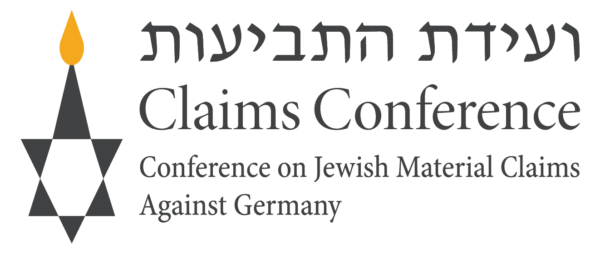Plaza at Former I.G. Farben Headquarters Renamed to Honor Pioneer in Slave Labor Compensation
[RoyalSlider Error] Incorrect RoyalSlider ID or problem with query.
Norbert Wollheim, a survivor of Auschwitz and the Buna/Monowitz labor camp, and the first person (in 1951) to successfully sue German industry for work performed while an inmate at a concentration camp, was posthumously honored as Goethe University Frankfurt renamed a plaza in his memory.
The University renamed the Grüneburgplatz as the Norbert-Wollheim-Platz. The space sits in front of the I.G. Farben Building, the former headquarters of the German conglomerate, which had used Jewish slave labor in its factories during World War II. Since 1996, the University has used the building for almost a dozen academic departments on its Westend campus. At the ceremony, Frankfurt Mayor Olaf Cunitz said renaming the large, park-like space gave the victims of I.G. Farben “their dignity,” and that it was “long overdue.”
The Claims Conference fought for more than a decade to rename the green space for Norbert, who died at age 85 in 1998. Together, Norbert and the Claims Conference established the process by which so many Shoah slave-laborers were able to receive compensation for their enforced labor under the Nazi killing regime. We are gratified that the University honored Norbert in this way, along with all of the other Jewish prisoners of Auschwitz who were forced to work for I.G. Farben.
Born in 1913, before the war Norbert had wanted to be a lawyer in Berlin, but the Nazis’ rise to power dashed his hopes. He played a pivotal role in administering the Kindertransport, which sent Jewish children from Germany and other occupied countries to England from 1938 to 1940.
In 1943, Norbert, his wife and their 3-year-old son were deported to Auschwitz. Upon arrival, his wife and child were murdered. Norbert was sent to the Buna/Monowitz labor camp, where he was forced, along with thousands of other Jewish prisoners, to build a chemical plant owned by I.G. Farben, which was notorious for manufacturing the Zyklon B gas used in the Nazis’ gas chambers. It was to be a factory for the manufacture of synthetic rubber. Norbert was liberated in 1945 in Germany by Allied forces.
As a founding member of the Central Council of Jews in Germany, Norbert was important in re-establishing Jewish communities in Germany after the Holocaust.
In 1951, Norbert sued I.G. Farben, with the support of the Claims Conference. He was determined to receive compensation for the two years he spent in slave labor to the company. After Norbert’s initial victory in the German courts, I.G. Farben decided to open talks with the Claims Conference, to encompass an overall settlement which would include all Auschwitz slave laborers who had worked in the I.G. Farben factory. In 1957 the Claims Conference and I.G. Farben agreed to a settlement of 27 million Deutschmarks for Jewish slave laborers, and an additional DM 3 million for non-Jews, who had been forced to work at the I.G. Farben facility in Auschwitz.
This agreement was the first between German industry and a Jewish organization regarding compensation payments to Jewish camp survivors. Wollheim’s suit and, subsequently, the Claims Conference agreement with I.G. Farben, paved the way for the Claims Conference to successfully negotiate various compensation payments from German companies – and eventually from the German Foundation “Remembrance Responsibility and the Future” – over the years for tens of thousands of Jewish slave laborers who were exploited by German industry during the Shoah. In initiating what was at first a test case, Norbert Wollheim truly became a hero to so many Shoah survivors who were slaves of the Third Reich’s war machine.
The I.G. Farben building was used by the American military government, starting in the post-war years and continuing through the Cold War until the mid-1990s, when Goethe University took over the building.
The Claims Conference, Buna-Monowitz survivors and University students have pushed to keep alive the memory of I.G. Farben’s involvement in the Holocaust, not only its use of slave-labor prisoners, but especially the Buna-Monowitz factory in Auschwitz, where Norbert Wollheim was forced to work.
The effort to rename the Grüneburgplatz – the postal address of Goethe University – into Norbert-Wollheim-Platz started in 2003, when the late Dr. Karl Brozik, z”l, then the Claims Conference Representative in Germany, made the proposal. Instead of a renamed plaza, in 2008 the Wollheim Memorial was inaugurated on the site (in the presence of former Claims Conference Executive Director Saul Kagan, z”l). The Wollheim Memorial is an artistic and pedagogical installation. The memorial website explains the history of I.G. Farben’s slave-labor practices, as well as Norbert’s story.
When the question of renaming the Grüneburgplatz for Norbert came up again in 2014, the Claims Conference was one of the movement’s strongest supporters.
Norbert’s courage in successfully suing I.G. Farben was the foundation upon which all subsequent Claims Conference negotiations with German companies for slave labor were based. We are grateful for Norbert’s efforts and help decades ago in this endeavor, and are gratified to have been part of the movement to honor him and his sacrifice as a slave-laborer.
The pioneers that fought for justice for Shoah survivors, such as Norbert Wollheim, z”l, Karl Brozik, z”l, and Saul Kagan, z”l, still inspire us to continue to pursue this vital objective, even as survivors reach their final years.
Watch a German-language video by the University of the naming ceremony.

